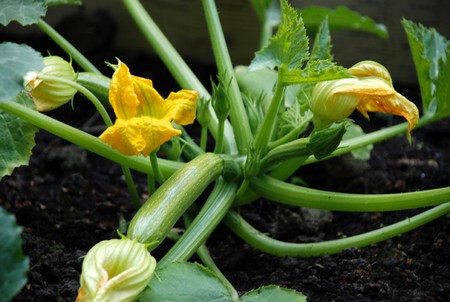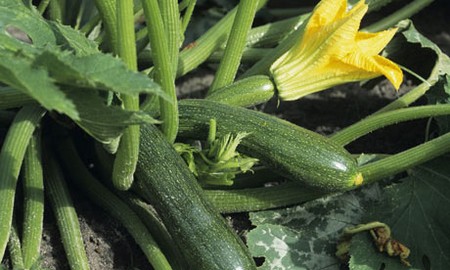Courgette plants take up a lot of space, spreading at least l m across. But, if you can find room for them in a border or a patio tub, you will be rewarded with a constant supply of tender courgettes throughout the summer months. The large, silvery-flecked leaves and bright-yellow flowers are attractive, too.
Do not make the mistake of growing a marrow variety and picking the fruits when they are still small. It is much better to start with a variety bred specifically for courgette production, or the total number of fruits may be disappointing.
A good choice of varieties is available, with long fruits in various shades of green and yellow. You could try an unusual round variety, or summer squashes, which are grown and cooked just like courgettes. Unfortunately, all courgette varieties produce bush plants, so if you want a plant with a climbing habit, it will have to be a trailing marrow.
Calendar
May
Courgettes are very sensitive to frost, so it is not worth planting them outside until all risk has passed. In most areas, this means waiting until early to mid-June. They are, however, very fast-growing plants. In very mild parts, and if you can provide a sheltered, sunny position, you could sow directly outdoors. But it is simpler to sow the seed in pots in a greenhouse or on a warm windowsill for planting out in June.
The seed is large and easy to handle. Sow it on edge into 7-cm pots and cover with compost. As the young seedling germinates it needs to push the whole seed out of the compost, otherwise it will rot. Given a minimum temperature of 18°C, plants germinate and grow very rapidly. Keep them well watered and if you cannot plant them out within four weeks, pot them on into bigger pots.
Gradually harden them off by putting them outside on warm days and moving them under cover on cooler nights.
June
It should be safe to plant out in mid-June in all but the coldest areas. Delay until later in the month if there is any chance of a late frost.
Unless the soil is already rich in organic matter, prepare a planting hole first. Dig a hole up to 30cm wide and deep. Refill with a mixture of soil and well-rotted manure or garden compost. This will leave a low mound. Water both the hole and the plant well and plant into the top of the mound. This will direct excess rain away from the base of the plant and help to prevent stem rot.
In a border, allow an area at least 1m in diameter for each plant. Although the plants grow as a bush, they tend to go in one direction, so give them plenty of room to avoid swamping neighbouring plants.
The best way to prevent weeds later in the summer is to cover the area with permeable plastic mulch before planting out. Cut cross-shaped slits in the plastic and plant through them.
Alternatively, mulch the soil around each plant with well-rotted manure, chipped bark or garden compost to suppress weeds and conserve moisture.
To grow a courgette plant in a container you will need one that can hold at least 30 litres of compost (or the contents of a standard growing bag). You will also need to water and feed regularly.
Water sparingly at first, aiming to keep the soil moist. Do not overwater or you will simply encourage too much leaf.
July – August
Once flowering starts, a good soaking once a week will be more effective in dry weather than regular light watering. Try burying a length of plastic drainpipe, or a large plastic bottle with the bottom cut off, about 20cm from each plant to direct water to the roots. This is especially worthwhile if you applied a mulch earlier.
Feed plants, especially those in containers, with a dilute tomato feed once a week.
Pick fruits regularly to encourage further cropping.
September-October
Most varieties will continue cropping until the first frost. To extend the season in areas prone to early frosts, surround the plants with a barrier of polythene sheeting at least 45cm high, supported by canes, or cover with garden fleece.

